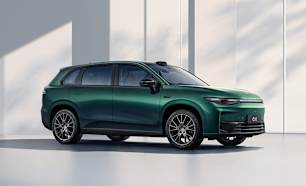Although the Leapmotor C10 REEV is a mid-size SUV, its interior space feels considerably larger and more spacious, especially in the second row. This is because the car is built on an EV architecture and has no driveline running down the middle, so interior space can be maximised.
Up front both seats are electrically adjustable, though neither of them offer adjustable thigh support which is a pain for people with longer legs, like myself, as it can sometimes feel like you’re slipping out of the seat. It doesn’t help that the seats are so soft and buttery.
I will say though, the heated front seats and steering wheel get warm almost instantly, which was great in the almost Arctic weather Melbourne has been experiencing recently.
While I can appreciate the minimalist design of the dashboard, from a practical standpoint it’s a huge pain. There’s virtually no physical switchgear beyond the indicator and gear selector stalks, with the majority of the controls built into the touchscreen multimedia system.
Want to adjust your side-mirror position, the air-vent direction, or drive mode? That all needs to be done via the touchscreen. Sure there are some buttons on the steering wheel which help with functions like adjusting the volume and cruise control, but it doesn’t do them all.
This is incredibly frustrating because when you do interact with the touchscreen on the move, the driver attention monitor chimes at you for not keeping your eyes on the road ahead.
Add to this, the touchscreen runs Leapmotor’s own operating system. Admittedly it does run really smoothly, but it doesn’t offer any smartphone mirroring functionality, which is a negative for some.
I imagine you would get used to using the selection of inbuilt third-party apps if you own this car, but I find the connected satellite navigation app particularly painful because it would send me on a slower route. Having Google Maps or Waze would be much more intuitive.
Up front there are two cupholders next to the wireless charging pad, a storage shelf under the centre console, a massive centre console box, a mediocre glovebox, a USB-A and USB-C port, and a 12V socket.
Moving to the second row, it’s arguably the best place to be in the C10 REEV. There’s oodles of space on offer and a completely flat floor.
At a leggy 182cm tall, I had plenty of legroom behind my driving position and also plenty to look at thanks to the huge fixed panoramic glass sunroof which, thankfully, has an electric block-out blind if the sun gets too bright.
The second-row bench feels like a big, soft couch in the best way. It’s leans backwards, allowing you to lay back and relax as a passenger.
One of the few things that detract from the space is high floor, due to the high-voltage battery pack placement. It makes you feel like your knees sit higher than normal.
Second-row amenities include centre console-mounted air vents, USB-A and USB-C ports, seat-back map pockets, door pockets, and a fold-down armrest. If you’re looking for cupholders, they’re right next to the air vents on the centre console.
Like the C10 EV, you can fold the front seats backwards to create an almost-flat space for lounging. You need to remove the front seat headrests to do this, but once you do it’s a cool novelty to show to your friends, or use while charging.
Around the back the tailgate opens quickly and quietly. Once it’s open the space on offer is decent, but not class-leading.
Leapmotor claims there’s 546 litres of boot space on offer with the rear seats upright, which is 35 litres less than the C10 EV. Folding the rear seats expands this space to 1375 litres.
Boot-related amenities include a retractable cargo cover, a light, some bag hooks, as well as two boot floor storage compartments for things like the charging cable.
Unsurprisingly, there’s no spare wheel of any kind in the C10 REEV. Instead you get a tyre repair kit under the boot floor, which is handy if you have a slow leak but not if you have a complete tyre blowout.






